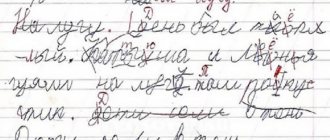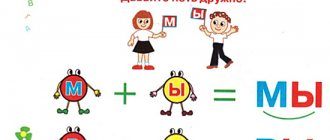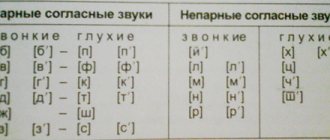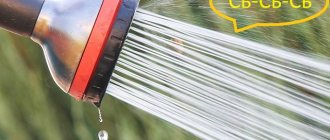Preface
A system of speech therapy measures has been proposed to eliminate such a difficult-to-correct, specific type of speech pathology in children of preschool and primary school age as a violation of the syllabic structure of words, a defect leading to the occurrence of dysgraphia and dyslexia.
The manual is addressed to practical speech therapists, primary school teachers, methodologists and teachers of specialized compensatory preschool educational institutions, as well as parents.
Formation of phonetically correct speech is an important task of speech therapy work with children of preschool and primary school age
Speech function is one of the most important human functions. In the process of speech development, he develops higher mental forms of cognitive activity and the ability for conceptual thinking. Mastery of speech contributes to awareness, planning and regulation of behavior. Speech communication creates the necessary conditions for the development of various forms of activity and participation in collective work.
It is known that the main functions of speech are communicative, generalizing and regulating. The communicative and generalizing functions of speech are formed in close unity: with the help of speech, a person not only receives new information, but also assimilates it. At the same time, speech is also a means of regulating higher mental functions of a person. Normally, the regulatory function of speech is formed by the end of preschool age and is of great importance for the child’s transition to school education. The formation of the regulatory function of speech leads to the emergence in the child of the ability to subordinate his actions to the speech instructions of an adult. Modern research in the field of child psychology has revealed that underdevelopment of the regulatory function of speech is a general indicator of abnormal mental development. This should be taken into account when carrying out correctional speech therapy work.
The formation of grammatically correct, lexically rich and phonetically clear speech in children, which enables verbal communication and prepares them for learning at school, is one of the important tasks in the overall system of teaching a child their native language in a preschool educational institution and in the family. A child with well-developed speech easily enters into communication with others, he can clearly express his thoughts, desires, ask questions, and agree with peers about playing together. Conversely, a child’s slurred speech complicates his relationships with people and often leaves an imprint on his character. By the age of 6-7 years, and sometimes earlier, children with speech pathology begin to realize the defects of their speech, experience them painfully, become silent, shy, and irritable.
Correction of violations of the syllabic structure of words
Lyudmila Sekach
Correction of violations of the syllabic structure of words
Among the various disorders in children, one of the most difficult to correct is a violation of the sound-syllable structure of words .
The most typical types of errors when reproducing words of different sound-syllable composition are the following.
Violation of the number of syllables:
- reduction (omission)
of a syllable (skein-hammer)
;
- deletion of the syllabic vowel (pinino - piano)
;
- increasing the number of syllables by inserting vowels into consonant clusters (room-room)
.
Violation of the sequence of syllables in a word:
- syllable (devore tree)
;
- rearrangement of sounds of adjacent syllables (hebemoth-hippopotamus)
.
Distortion of the structure of an individual syllable :
- reduction of consonant clusters (tul-stool)
;
- insertion of consonants into a syllable (lemont-lemon)
.
Similarity of syllables (coconuts-apricots)
.
Perseveration (bil. bili. bilitarian-librarian)
.
Antipations: sound ( syllable )
replaces the repressed sound
(
syllable ) in
the word (devero-tree)
.
Contamination: mixing elements of words (in the refrigerator - in the bread box and refrigerator)
.
Combinations of different types of distortions within the same word . For example, not saying a word and shortening a consonant in a consonant cluster (sada-soldier)
.
Changing the structure of a word beyond recognition (umavo - airplane)
.
The predominance of errors, expressed in the rearrangement or addition of syllables , indicates a primary underdevelopment of the child’s auditory perception. Errors such as reducing the number of syllables , assimilating syllables to each other , reducing consonant clusters indicate a predominant violation of the articulatory sphere.
Speech therapy work to correct violations of the sound-syllable structure of words is part of the general correctional work in overcoming speech disorders and is planned strictly individually for each child, depending on the type of speech pathology, level of speech development, age and his individual capabilities. Various approaches to correcting the sound-syllable structure of words in children with speech disorders are considered in the works of A. K. Markova, Z. E. Agranovich, S. E. Bolshakova, N. S. Chetvertushkina, T. A. Tkachenko, N. Kurdvanovskaya. V., Babinoy G.V., Krupenchuk O.I., etc. Most authors pay attention to the need to form in children psychological mechanisms that mediate the formation of the sound-syllable structure of words in ontogenesis ( successive (sequential)
abilities, development of a sense of rhythm and motor sphere, clarification of spatio-temporal concepts, development of inter-analyzer interaction, etc., sensory and motor parts of the speech process.
Speech therapy work to eliminate violations of the syllabic structure of a word cannot be limited to the purely corrective task of correcting only this deficiency. It should be developmental and include work on phonemic awareness, vocabulary , grammatical forms, and the development of intellectual functions (thinking, memory, attention)
.
Chetverushkina N. is the basis for the selection of practical material for . S. is based on many years of experience in practical work with preschoolers, the principle of a systematic approach in the correction of speech disorders and the classification of A. K. Markova, who identifies 14 types of word syllabic structure according to increasing degrees of complexity. Words become more complex both in increasing the number of syllables ( words are one-syllable , two-syllable, three-syllable and four-syllable, and in relation to the complexity of the syllable (open and closed, forward and backward, syllable with and without consonants):
1. Two-syllable words made from open syllables .
2. Three-syllable words made from open syllables .
3. Monosyllabic words .
4. Two-syllable words with a closed syllable .
5. Two-syllable words with a flow of consonants in the middle of the word .
6. Two-syllable words made from closed syllables .
7. Three-syllable words with a closed syllable .
8. Three-syllable words with a combination of consonants.
9. Three-syllable words with a combination of consonants and a closed syllable .
10. Three-syllable words with two consonant clusters.
11. Monosyllabic words with a combination of consonants at the beginning or middle of the word .
12. Two-syllable words with two consonant clusters.
13. Three-syllable words with a combination of consonants at the beginning and middle of the word .
14. Polysyllabic words made from open syllables .
The entire system of work on correcting violations of the syllabic structure of a word is designed for 2 academic years (senior and preparatory group)
.
The choice of methods and techniques of correctional work to eliminate violations of the sound-syllable structure of words in preschoolers is always preceded by an examination of a speech-language pathologist.
Correcting violations of the sound-syllable structure of words is quite complex and time-consuming. Studies have shown that it takes from 70 to 90 repetitions of a new word to an adult child for it to lead to the correct use of the word by the child himself .
Corrective work to overcome violations of the syllabic structure of words consists of the development of speech-auditory perception and speech-motor skills. Corrective into two stages:
• preparatory (work is carried out on non-verbal and verbal material; the goal of this stage is to prepare the child to master the rhythmic structure of words in his native language );
• actual correctional (work is carried out on verbal material; the goal of this stage is the direct correction of defects in the syllabic structure of words in a particular speech-language pathologist child).
Preparatory stage
At this stage, the child is offered tasks first on non-verbal material, and then on verbal.
Working on non-verbal material
1. Games and exercises for the development of concentration of auditory attention, auditory gnosis (FOOTNOTE: Auditory gnosis - recognition of an object by its characteristic sound) and auditory memory based on non-speech sounds (Where did they call? Recognize a musical instrument by sound . How many times did they hit the drum).
2. Work on rhythm (first on simple, then on complex)
.Children are offered various ways to reproduce rhythm: clapping their hands, tapping a ball on the floor, using the musical
instruments of a drum , tambourine, and metallophone.
The types of tasks are as follows:
• Clap your hands as many times as there are dots on the die (how many dots are on the card)
;
• Count how many times you clap your hands and pick up the card with the corresponding number (the rhythm is first suggested simple, then complex)
;
•Comparison of rhythms: !; !;
• Recognition of rhythms and correlating them with a certain rhythmic pattern written in symbols;
• Reproduction of a certain rhythm according to the model of a speech therapist, according to a given pattern;
•Tasks using stress to highlight part of a rhythmic pattern: !; !;
• Arbitrary reproduction of the rhythm by the child followed by recording of the rhythmic pattern with symbols;
• Playing long sounds (pipe, harmonica symbol «-»
) and short (drum, tambourine symbol
«+»
).
The rhythmic pattern can be as follows: —++, ++-+—, etc.
3. Formation of general coordination of movements to rhythmic music: marching, easy running, walking.
Note. These types of work can be carried out both in music classes and in logarithmics, if the correction is carried out in a speech therapy preschool educational institution.
4. Exercises to develop dynamic praxis of the hands: performing movements (with the left, right hand, two hands)
according to a model, according to
verbal instructions or by counting : fist edge, fist edge palm.
5. Exercises to develop reciprocal hand coordination: performing movements with both hands simultaneously (fist of the left hand, edge of the right hand, etc.)
.
6. Graphic exercises for switching (continue the line)
: 0-0-0. ; +=+=.
Note. Types of work and methods of presenting tasks are selected taking into account the age, intellectual and speech development of the child.
Working on verbal material
1. Games and exercises aimed at developing such spatial-temporal concepts as beginning, middle, end; before, behind, after; first, last. These concepts are important when a child masters the sequence of sound-syllable series , the sound content of words of a simple and complex syllabic structure .
For the purpose of propaedeutics to familiarize children with the sound-syllable series, we can recommend the creation of didactic game situations using, for example, the Russian folk tale “Turnip”
.
This type of work was proposed by speech therapist E.V. Rybina (FOOTNOTE: Rybina E.V. Didactic games in preparation for sound analysis // Defectology. 1989. 4). During the conversation with the child, concepts are clarified and reinforced in his passive and active vocabulary : first last, beginning middle end, between before before after (Who pulled the turnip first? Who stood between grandfather and granddaughter? Who stood behind grandmother? Etc. .).
For children with a low level of speech development (ONR-1, ONR-2)
The proposed types of work are not available.
Therefore, in early preschool age, it is recommended to begin preparatory work with exercises to develop auditory perception, to develop the ability to listen to an adult’s , to carry out simple instructions , and assignments. During classes, children get acquainted with simple musical instruments such as pipe, drum, rattle, tambourine, and bell. Children learn to recognize musical toys by ear without visual reinforcement, show the sounded instrument , and remember its name. , concepts such as quietly loud are introduced
into the passive and then into the active vocabulary At this stage of work, children also learn to distinguish loud (colloquial)
and whispered speech, learn to listen to the speech
of an adult , and clearly follow instructions given in a whisper. In the process of working with younger preschoolers, you can conduct game activities to develop imitation (Do as I do: performing movements according to the example of an adult , games accompanied by speech (Hands to the sides in a fist, unclench and on the side, simple exercises to develop dynamic praxis of the hands ( Show your palms, hide your palms: clench your hands into fists, unclench)
.In addition, children are asked to perform actions with musical toys
(Blow the pipe)
.If the child is familiar with the concepts of one many, then the task may be as follows: Blow the pipe many times. Blow the pipe once. All of the above types of exercises gradually prepare the child for mastering the rhythmic
structure of his native language .
The formation of sound pronunciation at this stage is not an independent task: it is closely related to the mastery of words of different syllabic structures . Children are taught to unconsciously divide words into syllables , syllable-by-syllable pronunciation words ... Reproduction of the word is accompanied by clapping in compliance with the rhythm. Direct identical syllables (yes-yes, yes-yes, syllables with different sounds (ma-pa, pa-ma, closed and reverse syllables (pap-ap)
.
In the process of conducting classes with children of the first level of speech development (ONR-1)
The child’s active attitude towards linguistic reality is consistently formed. The key point at this stage of training is a specially organized emotional game with a specific educational and speech task.
Corrective stage
Corrective work is carried out on verbal material and consists of several levels. Particular importance at each level is given to “engagement in work”
in addition to the speech analyzer there is also an auditory, visual and tactile one.
Vowel level
Children are offered the following tasks:
• Say the sound A as many times as there are dots on the cube;
• Say the sound O as many times as the speech therapist clapped his hands;
• Singing a series of sounds with clear articulation, repeating sounds after a speech therapist, reading letters, writing a series of letters (auditory and visual dictations)
: A U I O; AU IA OA; AUI IAU; AUA UAU; AUIA IUAO;
•The same tasks with emphasis on the shock sound: AUA, AUA, AUA;
• Recognizing a series of sounds by silent articulation and pronouncing them with a voice;
• The speech therapist taps out a rhythm, and the child must, in accordance with this rhythm, pronounce vowel sounds as follows: A-AA; AA-A; AAA; AAA-AAA.
Syllable level
It is advisable to carry out these types of work at the stage of automation and differentiation of sounds practiced by a speech therapist. The tasks can be the following:
• Compiling all possible syllables from the given letters ( “Who is bigger?”
);
• Stringing rings onto rods while simultaneously pronouncing a chain of syllables syllable for each ring )
;
• Exercise with fingers “Fingers say hello”
(for each contact of the fingers of a hand with the thumb of the same hand, one
syllable );
• Count how many syllables the speech therapist pronounced ( straight , reverse, consonant syllables)
;
• Name the stressed syllable in the chain of heard syllables ;
• Syllable building ( “ Say one syllable more than I do”
): sa-so. ;
• Reducing the number of syllables ( “Say one syllable less than I did”
): sa-so-su-sy;
• Reading chains of syllables : sa-so-su-sy; sy-sa-so-su;
• Tapping syllable chains by touching the thumb and middle or thumb and index fingers of the leading hand, and the same syllables are tapped with the same fingers: sa-so-so, so-sa-so;
• Reading or repeating a series of syllables :
a-sa, a-so, a-su, a-sy;
i-sa, i-so, i-su, i-sy;
u-so, u-so, u-su, u-sy;
o-sa, o-so, o-su, o-sy;
• Memorizing and repeating a chain of syllables : sa-so-so; so-sa-sa; sa-so-sa; so-sa-so; sa-sa-so; so-so-sa;
• Repeat after the speech therapist, reading a series of syllables with a combination of consonants: hundred-hundred-stu-sty;
o-sta, a-hundred, a-stu, a-sta;
and-sta, and-hundred, and-stu, and-sta;
oh-hundred, oh-hundred, oh-hundred, oh-hundred;
u-sta, u-stu, u-stu, u-stu.
Note. In some cases, articulation exercises can be replaced with exercises for pronouncing combinations of consonant sounds, but they include only those sounds that the child can pronounce correctly.
• Come up with a chain of as many syllables as dots appear on the die, write down the syllables ;
• Come up with a syllable for the scheme : SG, GS, SGS, SSG, GSS;
• “Say the opposite”
(ball game)
: sa-as, tsa-ast;
• Fluent reading of syllabic tables with forward and backward syllables , syllables with consonant clusters;
• "Who is faster?"
: the table contains
syllables (of different types)
;
the child must quickly find and read the syllable ;
• Recording syllables of various types under dictation;
• Recording chains of syllables of varying lengths, emphasizing vowels or consonants, hard or soft consonants, voiced or voiceless consonants; performing sound-syllable analysis of a chain of syllables (depending on the correction task )
;
• Visual dictation of a chain of syllables containing syllables of various types .
Word level
When practicing words of different syllable structures, the following must be taken into account:
• the structure of words being mastered expands and becomes more complex due to the structures ;
• the formation of the syllabic structure of words is carried out on the basis of certain word , which are fixed both in isolation and as part of a phrase;
• in the most severe cases, work should begin with evoking or consolidating the onomatopoeic words . (Particular attention should be paid to the repetition of onomatopoeia, which creates certain opportunities for mastering the syllabic series , for example: aw-aw, meow-meow.)
• the transition to two-syllable words is carried out using already acquired simple syllabic constructions : children are offered two-syllable words like SG + SG with the same repeated syllables (mother, woman)
.
At the initial stage, with a low level of speech development, the main task of speech therapy is the accumulation of an elementary expressive vocabulary by inducing imitative speech activity in children in the form of any sound manifestations, as well as expanding the volume of understood speech. At this stage, it is recommended to use words with a simple syllabic structure that do not include the articulation of complex sounds, and the main goal is to clarify the contour of the word (its length)
.
Work with “non-speaking”
children begins with inducing or reinforcing onomatopoeia.
Then it is advisable to move on to working with words like S G , S GS (on, give, here, here, there)
. Their pronunciation is usually accompanied by gestures.
After the child has a need to imitate the word of an adult , it is necessary to get him to reproduce the stressed syllable , and then the intonation-rhythmic pattern of one-, two- and three-syllable words (the child can perceive the sound composition of the word approximately; at this stage it is not recommended to correct the sound pronunciation) . You should pay attention to the formation of a coherent statement combining two words into one sentence (Dai bibi)
.
Great importance is attached to the selection of lexical material for classes that would prepare the child for verbal communication and the development of the communicative function of speech. Everyday vocabulary is used words related to various parts of speech. For more active and successful learning of the material during speech therapy classes, it is recommended to create various game situations.
Thus, the nature of the speech therapy intervention in the development of the syllabic structure of a word is determined by the level of speech development of the speech-language pathologist child, as well as individual difficulties in mastering the elements of speech. As already noted, the development of the syllabic structure of words is carried out on the basis of certain word , which are fixed both in isolation and as part of phrases.
The order of practicing words with different types of syllabic structure was proposed by E. S. Bolshakova in the manual “The work of a speech therapist with preschoolers”
.
The author proposes a sequence of work that helps clarify the contour of the word :
• Two-syllable words made of open syllables (vata)
;
• Three-syllable words made from open syllables (machine)
;
•monosyllabic: words representing a closed syllable (poppy)
;
• two-syllable words with a closed syllable (lemon)
;
• two-syllable words with a cluster of consonants in the middle of the word (bank)
;
• two-syllable words with a closed syllable and a consonant cluster (teapot)
;
• three-syllable words with a closed syllable (teremok)
;
• three-syllable words with a consonant cluster and a closed syllable (bus)
;
• three-syllable words with two consonant clusters (matryoshka)
;
• monosyllabic words with a consonant cluster at the beginning and end of the word (flag, screw)
;
• two-syllable words with two consonant clusters (star)
;
• four-syllable words made from open syllables (corn)
.
In the process of practicing words with different types of syllable structure, you can use the following types of games and exercises.
Phonemic and syllabic analysis of words
1. Game "Telegraph"
:
“transmit” a word by tapping out its rhythmic structure (number of
syllables ) .
2. Game with a ball: hit the ball on the floor as many times as there are syllables in the word ; the beats are accompanied by clear pronunciation of the syllables .
3. Dividing words into syllables , pronouncing syllables while simultaneously performing a mechanical action (stringing rings onto rods)
;
compare words : where there are more rings, the word is longer .
4. The child writes down a number indicating the number of syllables in a word ( the speech therapist dictates the words )
.
5. Analysis of a word with quantitative and qualitative analysis of its sound-syllable composition .
6. Parsing a word according to the scheme : how many syllables are in a word , which syllable is first , last, which syllable comes before a given syllable , after a given syllable , between given syllables .
7. "Cut pictures"
: cut the pictures into as many equal parts as there are
syllables in the word , sign, name each syllable .
8. “Place the animals in their homes”
: one-story house cat, two-story fox (
write syllable “floor”
of the house).
9. Playing with a ball: children pass the ball to each other and at the same time name a syllable of a word ; the child who received the ball calls the next syllable , etc.
10. Explain the meaning of the word steamer ; what 2 words is it formed ?
11. Correct the mistake in the words : hammer, mokolo. Options:
• words are written incorrectly;
• words are pronounced incorrectly (if it is difficult for a child to complete a task, a picture is given to help)
.
12. Name the extra word : monkey, hippopotamus, giraffe, crocodile.
13. What has changed in the word ? Fox fox fox.
14. The child is offered a series of pictures ( words) , from them he must choose the longest word , the name of the depicted object, the shortest, name words with the same number of syllables .
15. The speech therapist shows pictures, and the children must show the number indicating the stressed syllable in the word corresponding to the picture.
16. Analysis of words : has the number of syllables in a word with the appearance of a new letter (sound? Bottom down; sewed sewed.
17.Call affectionately: Olya Olenka, Vova Vovochka, etc. ( syllabic analysis of words )
.
18. Reading words devoid of meaning, clapping the rhythmic structure of the word .
19. Which words rhyme and which don’t; analysis of the number of syllables in them : cancer, tank, so, banana.
20. Find identical sound combinations of three sounds (letters)
in
words : wig, steam, hairdresser, hairdresser, steamboat. Combine these words into 2 groups according to their meaning. Find the longest word and the shortest one . Explain the meanings of words .
21. The child is offered a number of words . You need to find the same syllable in all these words : plane, milk, straight, ice cream.
22. Clarification of the rules for hyphenation of words in the Russian language and the syllabic-forming role of vowels vowel sounds in , as many syllables ; but you cannot separate by hyphenation a syllable consisting of one letter Anya, yula, wasp, etc. (2 syllables , but you cannot hyphenate a word )
.
Phonemic and syllabic synthesis of words
1. Complete these syllables with the same syllable ША : MA+, KA+
2. Solve the puzzles: KOF. LAS. KOS.
“Build”
a word from the cubes , connecting the cubes with arrows: LET SA MO
4. Form one word from two words : ice, chop (icebreaker)
.
5. The speech therapist slowly pronounces the word syllable by syllable : so-ba-ka, and the child pronounces this word in its entirety .
6. "Cut pictures"
.
The child is given the task of putting together a picture that is cut into as many parts as there are syllables in the word . They explain to the child that if the picture is put together incorrectly, the syllables will change places and the word will lose its meaning .
7. Form a word by analogy word formation exercise )
: house house, cat.
Find out what sound combination appears in all these words .
8.Change by analogy: house at home, forest. ( inflection )
.
Clarify whether the number of syllables .
9. Complete the word with a suitable syllable : earthlings., smo-rodi.
10. Select syllables from the table and make up the words : MASHA, PAWS, HURRAY, EARS, FRAME, OURS, OURS, LARA, RANA, TIRE, MARA, PASHA, MALA, MASHI, LAMA. MA RA NA SHA U LA SHI PA
11. From cards on which syllables , make up words that are devoid of meaning and read them.
12. Add a syllable to the names of the objects shown in the pictures: cars, cubes.
Mixed exercises for analysis and synthesis of words
1. Swap the syllables , make up the word : glad hole, pine pump.
2. Form a new word from the first syllables of two words : teapot + cabbage = seagull, raspberry + car = mom
3. One child pronounces the word slowly syllable by syllable : pu-go-vi-tsa, and the other pronounces this word in its entirety .
4. Determine which syllable is missing : ko-va; sa—let.
Phonemic representations
1. Arrange the pictures under word : (oak)
(pine) (birch) (cat) (goat) (cow)
2. Build “houses”
,
“place”
words there
enter one
syllable for each “floor” ):
• CANCER ZI VO
• MA RO
• TA
3. Come up with related words for the word snow (snowman, snowball, snowflake, snowy)
task similar to the previous one.
4. Name any word , come up with a word one syllable longer (shorter)
;
a similar task with pictures (selection of pictures)
.
5. Come up with words consisting of 1, 2, 3, 4 syllables .
6. Chain of words (children come up with a word starting with the last sound of the word ): tiger fish.
7. Finish the word : la., la., la., ma., ku.
8. Come up with words for the diagrams :
• CA. (porridge)
• CA. (viburnum)
• —KA. (mittens, pasta)
• —KA (spoon, handle)
9. Come up with words ending in -CHOK (heel, cricket)
.
10. Come up with names for the dolls consisting of 2 and 3 syllables ; give them gifts whose names consist of 2 and 3 syllables (pictures are used)
; explain why no one was given a COAK and SANDALS.
11. Come up with words that match the rhythmic pattern:
• !; !; !; !;
•! !’ !’ !’.
12. Come up with a simple saying based on the example: sho-sho-sho good; shi-ish-shi.
13. Find a rhyme for the words : poppy hammock; bunny.
14. Arrange the pictures into two piles: who is this? So what is this? Explain the meaning of the words : builder, construction; wig, hair salon, hairdresser; plumber, plumber; watch, watchmaker; police, policeman.
15. The child is offered a sound combination with a combination of consonants; words with this sound combination (praise, grab, enough)
.
When practicing words of different syllabic structures, it is necessary to pay attention to the meaning-forming role of phonemes and the semantics of words .







